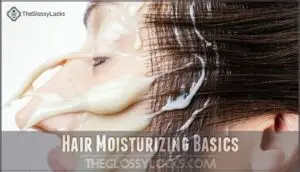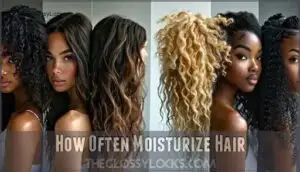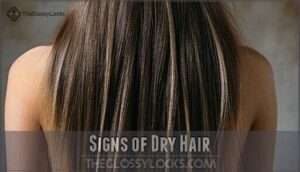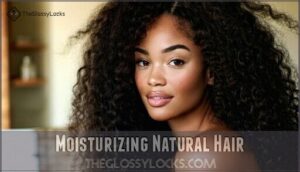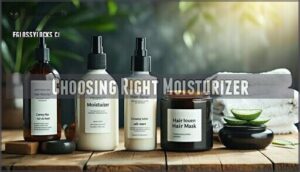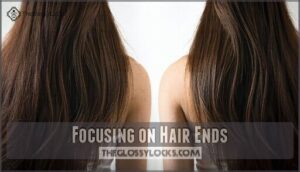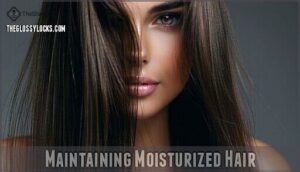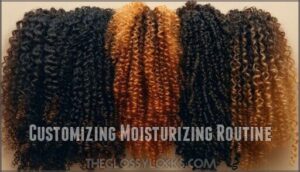This site is supported by our readers. We may earn a commission, at no cost to you, if you purchase through links.
 How often should you moisturize your hair? It depends on your hair type and what it needs.
How often should you moisturize your hair? It depends on your hair type and what it needs.
If your hair is curly or dry, daily moisturizing might keep it soft and happy, especially the ends. Straight or oily hair? You can likely stick to once or twice a week.
Look for signs like frizz, brittleness, or that “crunchy” feeling—those are your hair’s way of saying, “Help!” Don’t forget, moisture isn’t just products; it’s also about drinking water and healthy habits.
So, listen to your hair—it’s smarter than you think. Finding balance is key, and a few tweaks can go a long way to keep your hair soft.
Table Of Contents
- Key Takeaways
- Hair Moisturizing Basics
- How Often Moisturize Hair
- Identifying Dry Hair
- Moisturizing Natural Hair
- Choosing Right Moisturizer
- Applying Moisturizer Correctly
- Maintaining Moisturized Hair
- Customizing Moisturizing Routine
- Frequently Asked Questions (FAQs)
- How often should I rehydrate my hair?
- How do you know if your hair needs to be moisturized?
- How can I tell if my hair is over-moisturized and what steps should I take to correct it?
- Can hair moisture levels vary by season?
- What are signs of over-moisturized hair?
- How do diet and hydration affect hair moisture?
- Can scalp health impact moisture retention in hair?
- What role does exercise play in hair moisture?
- Conclusion
Key Takeaways
- Pay attention to your hair type—curly or dry hair benefits from daily moisturizing, while straight or oily types can stick to once or twice a week.
- Check for dryness signs like frizz or brittle ends and moisturize as needed to restore hydration.
- Use water-based products to hydrate and oils to lock it in, and focus on the ends where dryness shows first.
- Adjust your routine based on seasons, lifestyle, or environmental factors to keep hair balanced and healthy.
Hair Moisturizing Basics
Keeping your hair moisturized isn’t just about slathering on products; it’s about balancing hydration and moisture to keep strands healthy.
Understanding the difference between adding water and sealing it in can make or break your hair care routine.
Hydration Vs Moisture
Think of hydration and moisture as keys to your hair’s health.
Hydration adds water, keeping strands soft and flexible, while moisture uses oils to lock it in.
Hydration keeps strands soft and flexible, while moisture locks it in—both are essential for healthy, happy hair.
It’s like drinking water, then applying lotion—both are a must!
Use water-based products for hydration benefits, and lightweight oils for moisture retention.
Balance is vital for your hair hydration schedule!
Understanding your hair’s unique hair porosity is also essential for effective moisturizing and maintaining good hair health.
Importance of Hydration and Moisture
Hydration Benefits and Moisture Significance go hand in hand, making hydration and moisture essential for healthy hair.
They improve hair elasticity, prevent breakage, and boost manageability. What’s better? Following a consistent hair hydration schedule keeps strands soft and lively.
To maximize your hair moisturizing frequency:
- Hydrate regularly.
- Moisturize to lock it in.
- Embrace flexible, shiny strands!
Benefits of Proper Moisturizing
When you keep up with regular hair moisturizing, it’s like giving your strands a daily pep talk.
Proper hydration and moisture enhance shine, prevent breakage, and improve elasticity, making your hair easier to style and healthier over time.
A consistent hair moisturizing routine boosts manageability and protects hair health, keeping strands soft and supple between washes, no matter the texture, which is crucial for maintaining hair health.
How Often Moisturize Hair
Not sure how often to hydrate your hair? It depends on your hair type, lifestyle, and even the weather. For most, weekly hair moisture routines work well, but dry, curly hair might need daily hydration.
Keep your scalp health in mind—it craves balance. Watch out for product buildup, which can block the benefits of hair hydration.
Here’s a quick guide for ideal frequency:
- Fine hair: Moisturize every 3–4 days to avoid weighing it down.
- Thick or curly hair: Consider daily hair moisture or every other day.
- Oily scalp: Space it out to avoid overdoing overnight hydration.
- Dry environments: Increase frequency due to environmental impact.
- Product-heavy routines: Detox weekly to keep scalp and strands fresh.
Balance is key for shiny, healthy hair! It’s about finding the right rhythm for your hair, considering factors like hair type, lifestyle, and the need to avoid product buildup to achieve healthy hair.
Identifying Dry Hair
You can often spot dry hair by how it feels and looks—rough, brittle, and dull are common giveaways.
If your strands tangle easily or remind you of an itchy sweater, they’re probably begging for moisture.
Signs of Dry Hair
Your hair’s behavior tells you a lot about dryness. A rough texture? That’s a red flag.
Dull appearance and frequent tangling make styling frustrating, while increased breakage weakens strength.
If post-wash frizziness sticks around instead of softness, your hair’s thirsting for moisture. Regularly moisturizing your hair shaft prevents these signs of hair dryness, keeping it happy and manageable.
Causes of Dry Hair
Too much shampooing, especially with harsh formulas, strips natural oils and worsens hair dryness.
Adding constant heat damage or frequent environmental exposure like sun or wind doesn’t help either.
Product buildup clogs strands, blocking hair moisture, while porosity problems make retaining hydration tough.
Manage these causes with smarter care habits, like gentler shampoo frequency and protection against environmental impact to improve hair health with smarter care.
Effects of Dry Hair on Hair Health
When your locks lose moisture, expect noticeable changes.
Breakage increases as strands become weak and brittle.
Split ends creep in, making hair look frayed.
A dull appearance replaces natural shine, and styling difficulty follows with uncooperative texture.
Protect hair health by prioritizing dry hair moisturizing.
Proper hair moisture keeps dryness at bay, preventing damage and preserving smooth, manageable hair texture.
Combat dryness by using mild, sulfate-free shampoos to protect your hair, which helps in maintaining smooth, manageable hair texture, and also aids in preventing damage, and ultimately leads to preserving natural shine.
Moisturizing Natural Hair
Keeping your natural hair moisturized can feel like a balancing act, but it’s key to keeping your curls soft and healthy.
Keeping natural hair moisturized creates soft, healthy curls that shine with vitality and resist the challenges of dryness.
By tailoring your routine to your hair’s needs, you can prevent dryness and enjoy strands that look and feel their best.
Curly Hair Moisturizing Challenges
Curly hair needs extra TLC because its curl pattern makes it tough for scalp oils to travel down, leading to dry ends.
Add in porosity impact, and moisture can escape easily.
Plus, product buildup and environmental damage don’t help!
Address these challenges by understanding your hair’s unique needs and using effective hair moisturizing routines designed specifically for natural hair and curly textures.
Tips for Moisturizing Curly Hair
Curls thrive on targeted care. Start moisturizing natural hair by using humectant-rich products to attract moisture.
Focus on product layering—apply a leave-in, then a cream or gel to lock it in. Protect curly hair at night with satin pillowcases or scarves.
For ideal hydration, consider using a specialized hair product. Revitalizing curls daily with a light water-based spray keeps them hydrated and bouncy without excess buildup.
Best Practices for Natural Hair Moisturizing
Protect your natural hair’s moisture by embracing nighttime protection, like satin pillowcases or bonnets, to prevent dryness.
Use protective styling to lock in hydration while reducing manipulation.
Revitalizing curls with a spray mix of water and humectants helps between wash days.
DIY moisturizers with aloe vera or oils can boost hydration. Consistently follow these hair care best practices!
Choosing Right Moisturizer
Picking the right moisturizer can make or break your hair care routine.
You’ll want to focus on products with hydrating ingredients like water or aloe vera and skip anything loaded with harsh chemicals.
Key Ingredients for Hair Moisturizer
Look for ingredients like humectants (glycerin, honey) to attract hydration, and emollients like coconut or avocado oil for added moisture.
Protein additives such as hydrolyzed wheat or silk strengthen strands, while natural oils like argan or jojoba seal in hydration.
Avoid silicones, as they can block moisture over time. Consider various product formulations for different hair types.
The right mix keeps hair soft and healthy.
Selecting Moisturizer for Hair Type
Finding the right moisturizer starts with understanding your hair type and porosity needs.
Straight hair benefits from lightweight, water-based options, while curly or thick hair craves heavier, nutrient-rich formulas.
Look for products with water or aloe as the first ingredient. Understanding different product types is also essential for ideal hair health.
Avoid oily products if fine hair is your jam—keeping hair moisture balance is about smart ingredient analysis!
Avoiding Harsh Chemicals in Moisturizers
When picking hair moisturizing products, check labels like a pro.
Avoid sulfates—they’re harsh and strip moisture.
Parabens and phthalates? Big no.
These can harm more than help.
Alcohol dries hair, which defeats your entire hair moisturizing routine.
Instead, lean on natural ingredients like aloe or shea.
Skip artificial fragrances; they’re pointless.
Let hair care products nourish, not stress.
Applying Moisturizer Correctly
Using your moisturizer the right way guarantees your hair gets the hydration it needs without unnecessary buildup.
Simple steps like focusing on your ends and applying in sections can make all the difference for soft, shiny strands.
Sectional Application for Even Coverage
To get the best results, focus on sectioning your hair for even product distribution. It guarantees thorough scalp coverage and promotes proper product penetration.
Follow these steps:
- Divide hair into small, manageable sections—don’t rush this part.
- Apply products using gentle hair moisturizing techniques.
- Massage evenly, distributing moisturizer to every strand effortlessly for balanced moisture.
Focusing on Hair Ends
Your hair ends are the oldest, driest part of your hair shaft, making them prone to split ends and damage. Focus your hair moisturizing routine here by using end-specific products or sealing hair ends with a thicker moisturizer.
For better End Hydration, gently massage product and invest time in Damaged End Repair efforts. One should also consider understanding hair porosity to guarantee proper moisture absorption.
| Problem | Cause | Solution |
|---|---|---|
| Split ends | Dryness, damage | Seal hair ends with oil |
| Breakage | Lack of hydration | Use end-specific products |
| Rough texture | Insufficient moisture | End hydration regularly |
| Tangling | Neglected hair ends | Focus on moisturizing tips |
| Dull appearance | Lost hydration over time | Revise hair moisturizing routine |
Mixing Moisturizer With Water for Better Absorption
Mixing moisturizer with water can boost absorption and even out application.
A spray bottle helps create a fine mist, ensuring better penetration and moisture balance.
Stick to a 1:2 dilution ratio for light hydration without overdoing it.
Lightly mist dry strands before applying the product.
This technique improves product distribution and supports your hair rehydration routine.
- Use a spray bottle for easy application
- Maintain a 1:2 water-to-product ratio
- Focus on even distribution and deeper moisture penetration
- Repeat hydration based on your hair moisturizing tips
Maintaining Moisturized Hair
Keeping your hair moisturized isn’t just about slathering on products; it’s about creating habits that lock in hydration and protect against dryness.
From battling harsh weather to preventing split ends, maintaining moisture can make all the difference for healthy, shiny strands, and this is crucial for healthy hair.
Preventing Moisture Loss
Your hair’s cuticle protection is key to moisture retention.
Use humectants like glycerin to attract hydration, but avoid product buildup by rinsing properly.
Protective styling reduces moisture loss, while a solid nighttime routine—like wrapping hair with a satin scarf—minimizes friction.
These hair moisture tips simplify your hair moisturizing routine and keep strands happy between your chosen hair moisturizing frequency.
Protecting Hair From Environmental Factors
When battling environmental factors, simple tweaks shield your hair from harm. Here’s how to protect against UV hair damage, pollution, and more:
- Wear hats or scarves for sun exposure and wind protection.
- Use leave-in conditioners to guard against hair moisture loss.
- Choose products with UV filters.
- Avoid overwashing to preserve natural oils.
- Limit heat styling during cold weather to prevent further hair moisture loss.
Regular Deep Conditioning for Hair Health
Deep conditioning is your secret weapon for happy, hydrated hair.
Aim for a deep conditioning frequency of once a week, adjusting for your hair’s needs.
Use moisturizing hair products or try DIY deep conditioners packed with natural goodness.
Balance protein vs moisture for stronger strands, focus on proper application techniques, and watch your hair care routine transform into the ultimate hair hydration guide.
Customizing Moisturizing Routine
You’ve got to adapt your hair care routine to fit your hair’s unique needs and quirks.
By considering factors like porosity, texture, and how quickly your hair dries out, you can keep it healthy without overloading it.
Adjusting Moisturizing Frequency
Your moisturizing frequency depends on seasonal adjustments, activity levels, and lifestyle factors.
Sweat from workouts or heat might mean more frequent hydration, while colder months could require richer products.
Adjust based on hair length and signs like dryness or product buildup.
Listen to your hair’s needs—everyone’s hair moisturizing routine is unique, and it’s essential to keep it flexible to match how often you hydrate hair, considering factors like dryness.
Considering Hair Porosity and Texture
Your hair porosity and texture influence how often you hydrate.
High porosity hair quickly absorbs moisture but loses it fast, requiring frequent moisturizing.
Low porosity hair repels water, so use heat or lightweight products for better absorption.
Fine hair benefits from light moisturizers to avoid buildup, while thick hair thrives with rich formulas.
Customize your moisturizing routine! Understanding your hair’s ability to absorb moisture is key to an effective routine with the right hair care approach.
Supplementing With Leave-in Conditioners and Oils
Leave-in conditioners and lightweight oils are great for long-lasting moisture. They boost hydration and seal it in, keeping hair soft and manageable.
- Use leave-in conditioner for extra hydration after washing.
- Apply lightweight hair oils like argan or jojoba sparingly.
- Adjust hair oiling frequency to your porosity.
- Focus oils on ends to prevent dryness.
- Layer products for maximum moisture retention.
Frequently Asked Questions (FAQs)
How often should I rehydrate my hair?
You should rehydrate your hair whenever it starts feeling dry or looks dull, which is typically every 3–7 days.
Pay attention to your hair’s needs—it’s better to refresh it lightly than let it stay parched!
How do you know if your hair needs to be moisturized?
When your hair feels rough like straw, looks dull instead of shiny, or tangles easily, it’s crying out for moisture.
If it’s frizzy after washing or breaks often, it’s time to moisturize!
How can I tell if my hair is over-moisturized and what steps should I take to correct it?
Your hair feels limp, gummy, or overly soft when it’s over-moisturized.
To fix it, clarify with a sulfate-free shampoo, use a protein treatment for balance, and avoid heavy moisturizers until your hair feels strong again.
Can hair moisture levels vary by season?
Yes, moisture levels can shift with the seasons.
Winter’s dryness demands extra hydration and moisture, while summer’s humidity might reduce the need.
Keep an eye on how your hair feels and adjust accordingly, focusing on complete concepts like these to ensure the best care.
What are signs of over-moisturized hair?
When your hair feels mushy, limp, or unusually stretchy—like overcooked spaghetti—that’s a clear sign of over-moisturization.
It might lack volume, break easily, or struggle to hold a style.
Balance hydration and proteins wisely!
How do diet and hydration affect hair moisture?
What you eat and drink impacts your hair’s health big time.
Staying hydrated and eating foods rich in vitamins (like B, E, and omega-3s) keeps hair moisturized, shiny, and less prone to breakage.
Can scalp health impact moisture retention in hair?
Think of your scalp as the soil your hair grows from—if it’s dry or unhealthy, moisture retention suffers.
A healthy scalp boosts hydration by balancing oil production and keeping your hair’s foundation strong, which can be considered a complete concept in understanding scalp health.
What role does exercise play in hair moisture?
Exercise boosts blood flow, delivering nutrients to your scalp, which helps keep hair hydrated and healthy.
However, sweat can dry hair out, so rinse or cleanse your hair after workouts to avoid moisture loss.
Conclusion
Did you know that about 43% of people regularly deal with dry or damaged hair?
Knowing how often you should moisturize your hair depends on your hair type and signs like frizz or brittleness.
Curly or dry hair may need daily care, while straight or oily hair often thrives with less.
Pay attention to what your strands need, use products suited for your texture, and protect your hair from dry environments.
A little effort keeps hair soft and shiny!
- https://www.gkhair.com/es/blogs/all-blog-posts/how-often-should-i-moisturize-my-hair?srsltid=AfmBOorEipV40Gzoilp6SVX1FppEX9SyPCpHubsXTJn_aTlFZmvn1E0e
- https://www.carolsdaughter.com/blog/hair/hair-care-tips/how-to-moisturize-hair.html?srsltid=AfmBOoqawEWwzYvH8xCpvFREWy0DIoKlaq81Oq8Rkn6ufMTb7vDMg9Wc
- https://www.quora.com/How-can-I-keep-type-4-hair-moisturized-when-it-loses-moisture-quickly
- https://www.reddit.com/r/Naturalhair/comments/42lpxh/how_often_do_you_moisturize_your_hair/
- https://www.youtube.com/watch?v=8dnhcPaRo64

